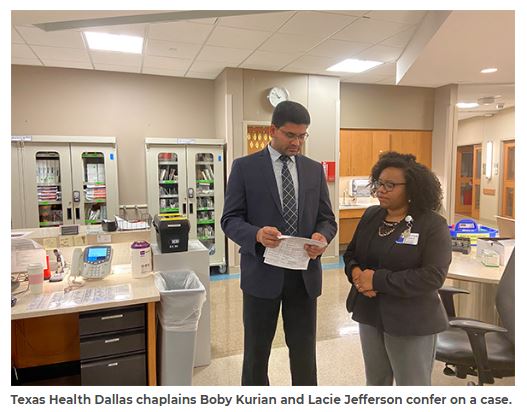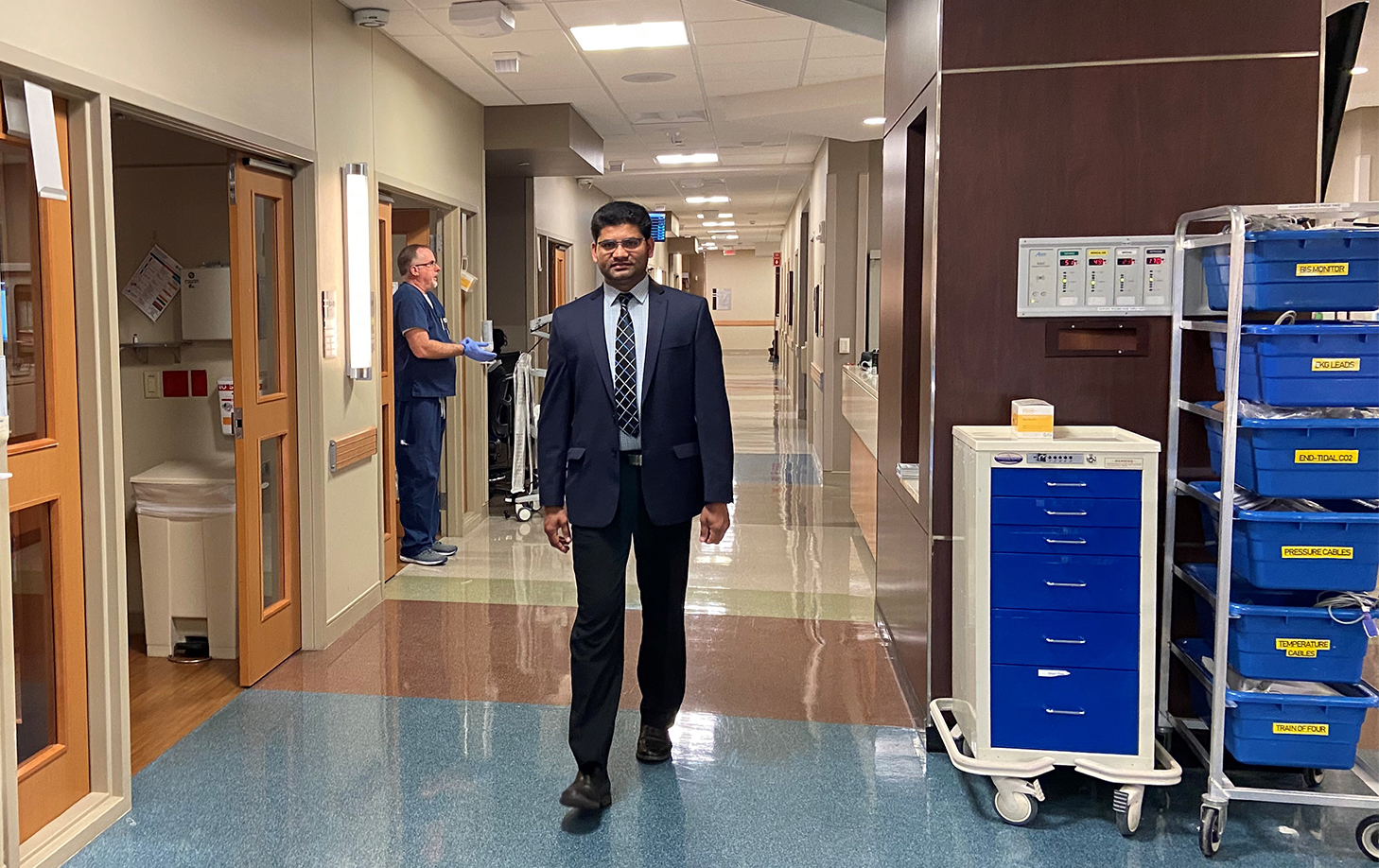Chaplain Boby Kurian stands at a patient’s bedside and quietly says the Lord’s Prayer, at the patient’s request. Around them, nurses are pulling on gloves and rolling away equipment, preparing to move the man out for a procedure.
But first, the patient wants a moment of spiritual solace with Boby.
The peaceful two or three minutes contrast sharply with the rest of Boby’s morning at Texas Health Presbyterian Hospital Dallas.
The day starts with a briefing at 8:30 a.m., when the five full-time Texas Health Dallas chaplains and Faith and Spirituality Integration Director Matthew Calvert gather to plan their day and learn from the night shift chaplain what transpired overnight. After the briefing, they launch out across the hospital for rounds. The pace is nonstop, and fraught with emotion and interruptions.
“You see people you’ve never met in their most vulnerable moments,” says Boby, a board-certified chaplain. Emotion, likewise, can affect the chaplains themselves.

For example, Boby has a nine-month-child and has found it’s tough for him to work with cases where a baby has died or is very ill. He has found spaces in the hospital for his own contemplation and moments of peace. One is the Legacy Room, where Texas Health Dallas’ history is chronicled with exhibits like a bright pink volunteer pinafore from the 1970s. The room is quiet and the exhibits absorbing.
“We complete spiritual assessments to determine whether consumers feel that their values have been heard by the medical team,” says Elizabeth Watson-Martin, M.Div, BCC, ACPE, vice president, Faith and Spirituality Integration. “We want to help build a care plan that has integrity, that they will want to follow. We want to do everything we can to empower our consumers to be able to use any resource that will help them. And faith is a primary resource for so many of our consumers.”
Rounds begin
After the briefing, Boby strides quickly down a corridor to participate in the daily trauma rounding with trauma surgeons, registered nurses, pharmacists and others. One patient was in a car accident and not doing well. Others are scheduled for procedures or beginning to heal from traumatic injuries. One, for example, has two broken femurs, broken ribs and still more injuries from a car accident.
Boby begins to walk the halls. Yellow signs on the doors indicate the trauma patients.
The first patient is asleep. Boby doesn’t wake the patient.
“I can always come back. They need their sleep,” he says. “It’s an important part of their recovery.”
By 10 a.m., he is in the cardiology unit, where he learns that at least two patients are having surgery and are receptive to visits from him before they go.
Clinical Nurse Leader Margaret Eckert, R.N., M.S.N., C.N.L., says Boby is “great to work with. He’s very involved. He touches base every single day and I read all his notes. I find Boby’s notes helpful because patients and their families open up to him and talk about their concerns. Then Boby’s writes a thorough note that helps me provide more comprehensive care for our patients.”
Emergency Department
As Boby makes his way from cardiology to the Emergency Department, a patient in shackles comes down the corridor using a walker. Two police officers and a nurse follow him.
“In Trauma we have to be very careful,” he says. “Especially with trauma involving crime.”
He said chaplains and caregivers will work with police to find out whether the patient is a suspect or a victim of a crime so they can gauge how family should be approached Sometimes police place restrictions on contacting family when an investigation is in progress.
In the trauma lounge, Boby pauses. This is where families come to await word about their loved ones, and a chaplain can often offer support.
The day before, Boby was with parents of a young man who was brought to the Emergency Department after a traffic collision. Boby offered support to the anxious family while their son was first evaluated in the trauma room and then taken to the operating room for emergency surgery. He stayed with them for four hours, until their son was transferred to the ICU, and facilitated their visit with him.
Boby also assured them he would be available for follow-up later.
Code Blue
On this day, as Boby continues his rounds, his Vocera alerts him to a Code Blue situation in the Emergency Department. Code Blue signifies cardiac respiratory arrest. The patient has already coded three times.
He rushes downstairs, but deliberately slows his pace as he approaches the department.
“It’s intentional, because I’m checking with myself,” Boby said. “Embodying a non-anxious presence is important for the pastoral affect we bring to our patients.
“Other caregivers can afford to be a little bit anxious, but a chaplain cannot.”
Once there, he finds the woman has been in a horrific car crash and is on life support. Chaplain Lacie Jefferson has already assisted the care team by locating the patient’s Do Not Resuscitate order. Co-workers are clustered at the bedside and Boby quietly approaches the physician, confers for just a few minutes and leaves the room.
“I am a caregiver to be there in their time of need,” Boby says. “But not to stand in the way of the other caregivers— doctors, the CPR team and nurses all have a lot to do for the patients.”
The patient is being kept alive until her daughter, who has medical power of attorney, can get to Dallas from New York. Boby or another member of the Pastoral Care team will offer support to the patient’s daughter when she arrives.
Boby remains calm and deliberate.
“In the midst of the whirlwind, our chaplains know how to have that non-anxious presence and peace,” says Elizabeth. “Within 10 minutes, our board-certified chaplains can have a powerful, life-changing conversation with someone that turns everything around.”
By Judy Wiley • Posted February 11, 2020



